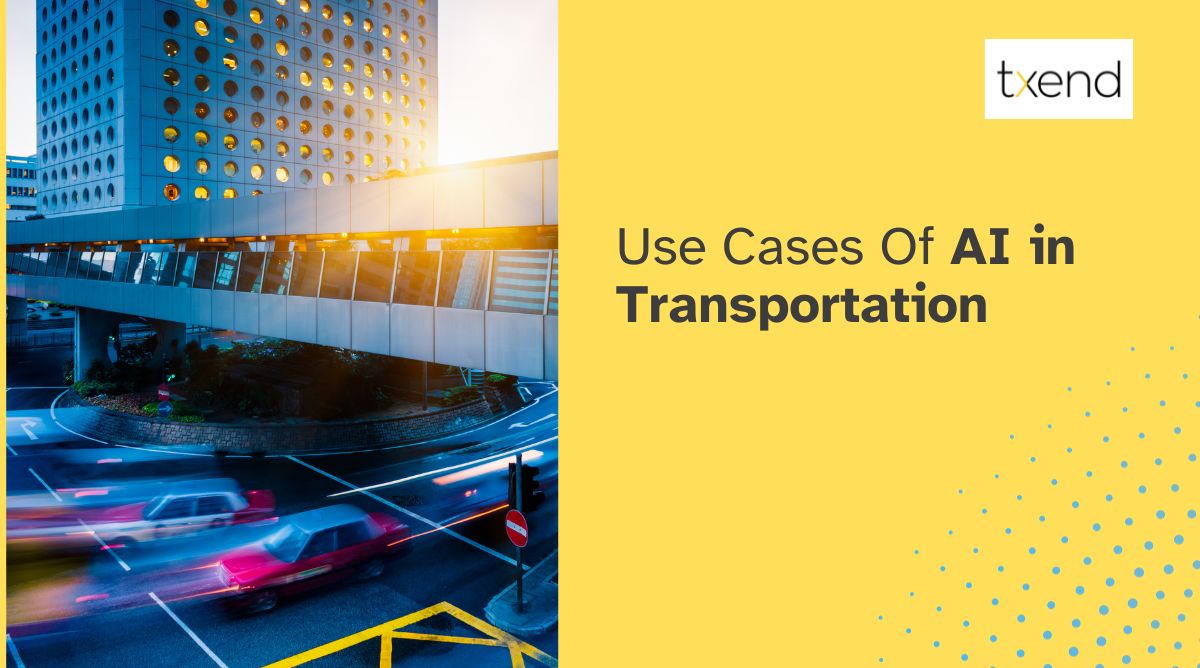
Are you ready to embark on a journey into the future of transportation in the United States? Buckle up as we explore the groundbreaking applications of AI in transportation and logistics. From revolutionizing delivery systems to enhancing safety and efficiency, AI drives innovation at full throttle.
In this article, we’ll delve into the exciting use cases of AI in transportation, uncovering how this cutting-edge technology is reshaping how we move people and goods. Whether you’re a technology expert or just interested in the latest trends, join us as we navigate the ever-evolving landscape of AI in transportation, where the road to progress is paved with data-driven solutions.
Key Takeaways
- AI in transportation optimizes routes, enhances safety, and enables the development of autonomous vehicles, revolutionizing the industry landscape.
- Benefits include improved safety, efficiency, and customer experiences, as well as optimized traffic management and sustainable transportation solutions.
- Best practices involve robust data analysis, collaborative partnerships, rigorous testing, and continuous monitoring, ensuring seamless integration and sustainable, ethical implementation.
AI In Transportation
AI in transportation is changing the game, shaking up how we get around in our world that’s more connected than ever. It’s not just about fancy technology; it’s about using smart computer programs and data insights to make transportation better.
This means things like making sure everything runs smoothly, keeping us safe, and being kinder to our planet. You might not realize it, but AI is behind the scenes, making sure packages get to your doorstep on time and helping traffic flow more smoothly on your commute.
It’s even making cars that can drive themselves! As AI keeps getting better at this transportation stuff, it’s making our future look brighter, with more ways to get around that are both clever and kind to the Earth.
Use Cases Of AI in Transportation
Autonomous Vehicles
AI enables the development of self-driving cars, trucks, and other vehicles that can operate without human intervention.
Example: Companies like Waymo and Tesla are actively testing and deploying autonomous vehicles, which have the potential to reduce accidents and improve the overall efficiency of transportation significantly.
Traffic Management
AI helps optimize traffic flow and reduce congestion by analyzing real-time data and adjusting signals and routes accordingly.
Example: Cities like Los Angeles and New York use AI-powered traffic management systems to improve the overall flow of vehicles and minimize delays during peak hours.
Predictive Maintenance
AI predicts maintenance needs for vehicles and infrastructure, helping to reduce downtime and prevent unexpected breakdowns.
Example: Companies like UPS use AI to monitor their vehicle fleets, enabling them to address issues and minimize service disruptions preemptively.
Demand Forecasting
AI analyzes historical and real-time data to predict transportation demand, helping companies optimize resources and provide efficient services.
Example: Ride-sharing platforms like Uber use AI algorithms to forecast demand, ensuring enough drivers are available to meet passenger needs during peak hours.
Route Optimization
AI algorithms help in optimizing delivery routes, reducing fuel consumption, and ensuring timely deliveries.
Example: FedEx and other delivery companies use artificial intelligence (AI) to help drivers plan the most efficient routes, which saves money and speeds up deliveries.
Supply Chain Management
AI optimizes supply chain operations by predicting demand, managing inventory, and improving efficiency.
Example: Major retailers like Walmart use artificial intelligence (AI) to optimize their supply chain, allowing them to control inventory levels and guarantee that goods are available when customers need them.
Fleet Management
AI assists in monitoring and managing large fleets of vehicles, ensuring optimal performance and reducing operational costs.
Example: Companies like Amazon utilize AI-powered fleet management systems to track their delivery vehicles, enabling efficient resource allocation and timely package deliveries.
Personalized Transportation Services
AI enables personalized transportation services, catering to individual preferences and optimizing travel experiences.
Example: Ride-hailing companies like Lyft leverage AI to provide personalized ride recommendations and tailored services based on user preferences and previous travel history.
Infrastructure Planning
AI aids in planning transportation infrastructure by analyzing data and predicting future needs for roads, bridges, and public transportation systems.
Example: City planners use AI to assess traffic patterns and plan the construction of new roads and public transportation routes to meet the growing needs of urban areas.
Intelligent Public Transportation
AI enhances public transportation systems by providing real-time updates, optimizing routes, and improving overall passenger experiences.
Example: Cities like Chicago and San Francisco utilize AI-driven systems to provide real-time information on public transportation schedules and optimize bus routes to accommodate changing passenger demands.
Smart Parking Solutions
AI helps optimize parking availability by providing real-time data on parking space availability and guiding drivers to open spots.
Example: Smart parking applications in cities like Boston and Seattle use AI to guide drivers to available parking spaces, reducing congestion and improving the overall parking experience.
Enhanced Safety and Security
AI enhances transportation safety and security by monitoring potential risks, providing real-time alerts, and enabling proactive measures.
Example: Airports and transportation authorities use AI-powered surveillance systems to monitor suspicious activities, ensuring the safety of passengers and transportation infrastructure.
Energy Efficiency
AI optimizes energy usage in transportation, reducing fuel consumption and promoting the adoption of eco-friendly vehicles.
Example: Electric vehicle manufacturers leverage AI to enhance energy efficiency and extend the range of electric vehicles, promoting sustainable transportation solutions.
Customer Service and Experience
AI improves customer service in transportation by providing personalized support, handling inquiries, and resolving issues efficiently.
Example: Airlines utilize AI-powered chatbots to assist customers with flight reservations, provide travel recommendations, and address customer concerns in real time, enhancing the overall travel experience.
Weather and Traffic Alerts
AI provides real-time weather and traffic alerts to help travelers plan their journeys accordingly and avoid potential disruptions.
Example: Utilizing artificial intelligence (AI), navigation apps such as Waze and Google Maps provide users with up-to-date information on traffic jams and weather, allowing them to select the most economical routes for their travels.
Benefits of AI in the transportation industry
- Enhanced safety through predictive maintenance and real-time risk assessment
- Improved efficiency in traffic management and route optimization
- Reduced operational costs through effective fleet management and resource allocation
- Enhanced customer experiences with personalized transportation services and real-time updates
- Sustainable practices promoted through energy-efficient transportation solutions
- Smoother supply chain operations with optimized inventory management and demand forecasting
- Better infrastructure planning with data-driven insights and predictive analytics
- Increased convenience for travelers through intelligent public transportation systems and smart parking solutions
- Enhanced security measures with AI-powered surveillance and risk monitoring
- Eco-friendly practices are facilitated by promoting electric vehicles and energy-efficient transportation solutions.
Best Practice for AI in transportation
- Robust data collection and analysis to ensure the availability of high-quality and relevant data for AI algorithms.
- Collaborative partnerships between AI technology providers and transportation stakeholders to foster innovation and address industry-specific challenges effectively.
- Rigorous testing and validation of AI applications to ensure their reliability, safety, and compliance with regulatory standards.
- Continuous monitoring and optimization of AI systems to adapt to changing transportation demands and improve performance over time.
- Integration of AI with existing transportation infrastructure and technologies to facilitate seamless operations and minimize disruptions during implementation.
- Investment in employee training and skill development to ensure a proficient workforce capable of effectively utilizing and managing AI technologies in the transportation sector.
- Prioritization of cybersecurity measures to safeguard sensitive data and maintain the integrity of AI-driven transportation systems against potential cyber threats.
- Emphasis on user-centric design and customer feedback to tailor AI solutions according to the specific needs and preferences of transportation users and stakeholders.
- Implement sustainable and ethical AI practices to promote environmentally friendly transportation solutions and ensure fair and transparent decision-making processes within the industry.
- Compliance with regulatory guidelines and standards guarantees the ethical and responsible use of AI in transportation, fostering trust and credibility among users and regulatory authorities.
How can Txend Help?
Predictive Maintenance and Fleet Optimization:
Txend can develop AI-powered predictive maintenance systems that analyze sensor data from vehicles to anticipate potential breakdowns and schedule maintenance proactively. This can help companies reduce downtime, extend the lifespan of their vehicles, and optimize their fleet management strategies.
Advanced Driver Assistance Systems (ADAS) and Autonomous Vehicles:
Txend can contribute to the development of autonomous vehicles and ADAS by providing expertise in AI algorithms, sensor fusion, and real-time data processing. These technologies can enhance safety, reduce accidents, and improve traffic flow.
Traffic Management and Route Optimization:
Txend can develop AI-powered traffic management systems that analyze real-time traffic data to optimize traffic flow, reduce congestion, and provide drivers with accurate route recommendations. This can save time, fuel, and reduce emissions.
Demand Forecasting and Logistics Optimization:
Txend can build AI-driven demand forecasting models that predict transportation needs based on historical data and external factors. This can help logistics companies optimize their operations, reduce empty miles, and improve customer service.
Fraud Detection and Security Enhancement:
Txend can develop AI-powered fraud detection systems that analyze transaction data to identify and prevent fraudulent activities in transportation and logistics. This can protect companies from financial losses and enhance security.
Frequently Asked Questions
AI is used in transportation for various purposes, including optimizing traffic flow, enabling autonomous vehicles, managing logistics and supply chains, enhancing predictive maintenance, and improving overall operational efficiency.
AI can solve challenges in transportation such as traffic congestion, inefficient route planning, high energy consumption, vehicle maintenance issues, and safety concerns by providing data-driven insights, predictive analytics, and real-time monitoring capabilities.
AI can disrupt the transportation industry by revolutionizing traditional practices, enabling the development of autonomous vehicles, enhancing efficiency and safety, and reshaping the way goods. People are transported, creating new opportunities and transforming the overall landscape of the industry.
AI can assist transportation systems by providing real-time traffic updates, optimizing route planning, enabling predictive vehicle maintenance, enhancing safety and security measures, facilitating efficient supply chain management, and promoting the development of eco-friendly and sustainable transportation solutions.
Conclusion
In the grand scheme of things, the introduction of AI in transportation is changing the way we get from point A to point B, and it’s doing so in remarkable ways. It’s not just about making things more efficient; it’s about creating a safer, more sustainable way of moving goods and people around.
With AI seamlessly integrating into transportation and logistics, we’re witnessing a transformation that’s making our journeys smoother and our future brighter. The applications of AI in transportation and logistics are laying the groundwork for a future where we can travel smarter, safer, and in ways that are kinder to our planet.
